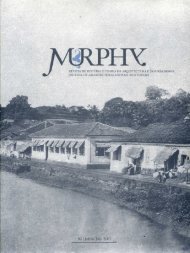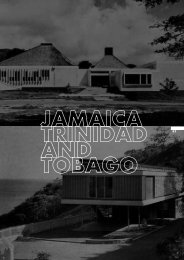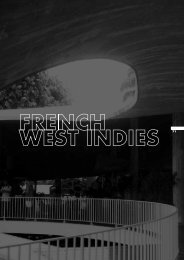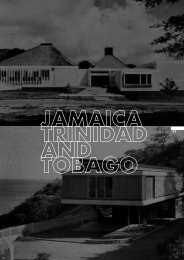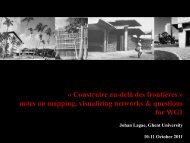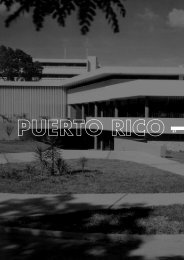Martinique, Case studies in modernism
Martinique, Case studies in modernism
Martinique, Case studies in modernism
You also want an ePaper? Increase the reach of your titles
YUMPU automatically turns print PDFs into web optimized ePapers that Google loves.
<strong>Mart<strong>in</strong>ique</strong>,<br />
<strong>Case</strong> <strong>studies</strong><br />
<strong>in</strong> <strong>modernism</strong><br />
EMMANUELLE GALLO AND JEAN DOUCET<br />
<strong>Mart<strong>in</strong>ique</strong>’s modern architecture is characterized by its widespread<br />
dissem<strong>in</strong>ation. Ow<strong>in</strong>g to its history, cyclonic destructions and seismic<br />
damage, <strong>Mart<strong>in</strong>ique</strong>’s heritage, prior to the n<strong>in</strong>eteenth century, is limited.<br />
72<br />
PART OF THE NINETEENTH CENTURY architecture<br />
survives <strong>in</strong> a conf<strong>in</strong>ed way, a church here, a market<br />
there, with an emblematic example: the Schœlcher<br />
library (1889), built follow<strong>in</strong>g architect Henri Picq’s<br />
plans. The bulk of extant constructions was realized<br />
dur<strong>in</strong>g the twentieth century when the number of<br />
dwell<strong>in</strong>gs tripled. In that respect, <strong>Mart<strong>in</strong>ique</strong> is located<br />
with<strong>in</strong> the American context although adm<strong>in</strong>istratively it<br />
Fig. 1. Basse-Po<strong>in</strong>te School, 1930s<br />
is part of Europe. In this context and dur<strong>in</strong>g that period<br />
(1927–1969), a good many of <strong>Mart<strong>in</strong>ique</strong>’s residents<br />
chose to endorse architectural modernity.<br />
MARTINIQUE’S MODERNITY was promoted by<br />
architects, among which Louis Caillat (1901–2002),<br />
Maurice de Lavigne Sa<strong>in</strong>te-Suzanne (1917–1992), but<br />
also by enthusiastic or determ<strong>in</strong>ed contractors and<br />
eng<strong>in</strong>eers: René Dant<strong>in</strong>, Constant Eudaric and Raoul de<br />
Jaham; and also by a few enlightened build<strong>in</strong>g sponsors<br />
such as Donald Monplaisir or pharmacist Charles<br />
Glaudon. However <strong>in</strong> <strong>Mart<strong>in</strong>ique</strong> this new architecture<br />
was not conf<strong>in</strong>ed to ‘learned’ architecture. Thanks to<br />
the realizations of many contractors and to menial<br />
draftsmen, a real dissem<strong>in</strong>ation of vernacular <strong>modernism</strong><br />
is patent. This commitment was an unusual feature of<br />
<strong>Mart<strong>in</strong>ique</strong>’s modernity.<br />
© photo Jean Doucet<br />
THE 1930s<br />
Apparently the first modern work <strong>in</strong> <strong>Mart<strong>in</strong>ique</strong> would<br />
have been for the Fort-de-France sail<strong>in</strong>g club <strong>in</strong> 1927,<br />
an unbuilt project by architect Gérard Corb<strong>in</strong> 1 of<br />
Guadeloupe (1905). The first modern build<strong>in</strong>g erected<br />
was l’Église du Prêcheur, probably built around 1930.<br />
A key factor seems to be at the orig<strong>in</strong> of this architecture’s<br />
development. Through the May 21, 1930 law, the French<br />
State allocated 50 million francs to <strong>Mart<strong>in</strong>ique</strong> to repair<br />
the damage caused by Mount Pelée’s last volcanic<br />
explosion <strong>in</strong> September 1929. 2 Concurrently the Conseil<br />
général (Regional Council) raised a public loan of 150<br />
million francs. 3 These efforts materialized as the renewal<br />
of many public constructions: town halls <strong>in</strong> Sa<strong>in</strong>t-Pierre<br />
(1934), <strong>in</strong> Grande-Rivière (1932), at Lament<strong>in</strong> (1934,<br />
Louis Caillat), schools <strong>in</strong> Basse-Po<strong>in</strong>te and Bellefonta<strong>in</strong>e<br />
Docomomo N°33<br />
September 2005
© photo Emmanuelle Gallo<br />
Fig. 3. Lycée Schœlcher,<br />
axonometric view<br />
73<br />
Fig. 4. Lycée Schœlcher, catwalks and flights of stairs<br />
© photo Jean Doucet<br />
© draw<strong>in</strong>g Rémi Lange<br />
Fig. 2. Lycée Schœlcher seen from the entrance, 1937<br />
(1930s), but also the Clarac hospital (1935, Wulfleff and<br />
Verrey) 4 and the Lycée Schœlcher (1937), as well as a<br />
volcanology observatory at the Morne des Cadets<br />
(1935, Louis Caillat) (fig. 1). It is worth mention<strong>in</strong>g that<br />
these projects occurred at a moment when <strong>in</strong> cont<strong>in</strong>ental<br />
France modern municipal build<strong>in</strong>gs were be<strong>in</strong>g constructed<br />
<strong>in</strong> Boulogne-Billancourt, Suresnes, Villeurbanne, Clichy,<br />
Villejuif, and for hospitals such as Beaujon <strong>in</strong> Clichy<br />
(1935, Jean Walter) and lycées (high schools) such as<br />
Camille-Sée (1934, François Le Cœur). In Guadeloupe<br />
architect Ali Tur (1889–1970), member of the Société des<br />
architectes modernes, developed a genu<strong>in</strong>e architectural<br />
œuvre with many public build<strong>in</strong>gs but also churches. 5<br />
THE LYCÉE SCHŒLCHER 6 (figs. 2, 3 & 4)<br />
The Lycée Schœlcher, designed for the tri-centennial, is<br />
implemented by stages between 1937 and 1938. With<br />
its 80,000 sqm built <strong>in</strong> a 4-hectare park, it is a highly<br />
significant work. The earthworks and reta<strong>in</strong><strong>in</strong>g walls of<br />
the hill overlook<strong>in</strong>g the Fort-de-France bay lasted nearly<br />
ten years, and the school’s construction itself began <strong>in</strong><br />
1933. Honoré Donat supervised the works. The post<br />
and beam structure, designed anti-seismically, was<br />
conceived by the Parisian civil eng<strong>in</strong>eers office Delefosse<br />
and Trompat. 7 The works were carried out by the<br />
Roy-Camille, Kalfon and Roseau firms of <strong>Mart<strong>in</strong>ique</strong>.<br />
The Lycée’s general composition consists of a central<br />
axis emphasized at the entrance by a clock tower. The<br />
layout makes the most of the hill, with build<strong>in</strong>gs spaced<br />
out on three terraces and positioned perpendicular to the<br />
slope, allow<strong>in</strong>g the trade w<strong>in</strong>ds to ensure crossventilation.<br />
The entrance provides, thanks to its staircase,<br />
a l<strong>in</strong>k with the first terrace and the adm<strong>in</strong>istration<br />
build<strong>in</strong>gs. Another flight of stairs provides access to the<br />
second terrace on which four teach<strong>in</strong>g build<strong>in</strong>gs are<br />
distributed around three courtyards fac<strong>in</strong>g the sea. The<br />
3-story constructions are connected to each other by<br />
outdoor but covered catwalks and stairways. The last<br />
Fig. 5. Haller, tri-centennial exhibition’s front gate, 1935<br />
© Corb<strong>in</strong> stock<br />
Docomomo N°33<br />
September 2005
terrace, which is situated between the second and third<br />
stories, welcomes three 4-story build<strong>in</strong>gs, around two<br />
courtyards. The clock tower extends the central build<strong>in</strong>g.<br />
All build<strong>in</strong>gs accommodate classrooms: covered outdoor<br />
galleries lead to the classrooms that cross through the<br />
build<strong>in</strong>gs. W<strong>in</strong>dows are endowed with wooden<br />
jalousies. Transparency, sequences of shallow steps, the<br />
rhythm of posts, roof-terraces and cont<strong>in</strong>uous bands of<br />
balconies produce entirely orig<strong>in</strong>al aesthetics. 8 Sadly,<br />
this first-rate ensemble is currently threatened with<br />
destruction, although it deserves to be rehabilitated, be<br />
it with a revised brief.<br />
IN 1935 an event celebrat<strong>in</strong>g the colony’s tri-centennial<br />
was organized <strong>in</strong> Fort-de-France at the Parc Gallieni.<br />
THE DORMOY HOUSE (fig. 6)<br />
Louis Caillat was commissioned by René Dormoy,<br />
construction and civil works eng<strong>in</strong>eer, and contractor, to<br />
build this residence. The rectangular ground floor<br />
welcomes a covered gallery lead<strong>in</strong>g to two liv<strong>in</strong>g rooms,<br />
a bedroom and a study. An adjo<strong>in</strong><strong>in</strong>g volume encloses<br />
the kitchen and bathrooms. The second story comprises<br />
two bedrooms with curbed walls, one of which opens<br />
onto a large terrace. W<strong>in</strong>dows, bear<strong>in</strong>g on high breast<br />
walls, closed by jalousies, are shaped <strong>in</strong>to cont<strong>in</strong>uous<br />
bands under the outcrop of the brise-soleils. A system of<br />
natural ventilation emerges on the façade like a concrete<br />
trellis. The stoneware floor replicates various rug patterns;<br />
the furniture <strong>in</strong> exotic woods was especially made to<br />
order. Today the house, over-exposed to the nuisances of<br />
74<br />
Fig. 6. Louis Caillat, Dormoy house, 1933<br />
© Dormoy stock<br />
Fig. 7. Louis Caillat, front gate of the Monplaisir house, 1946<br />
© draw<strong>in</strong>g Rémi Lange<br />
The exhibition entrance’s strik<strong>in</strong>g feature is a monumental<br />
modernist front gate, no doubt <strong>in</strong>fluenced by the<br />
aesthetics of the 1925 Arts décoratifs World Fair (fig. 5).<br />
Architect Robert Haller is the author of the exhibition’s<br />
layout and of the 15-meter high founta<strong>in</strong> of light also set<br />
up at Terres-Sa<strong>in</strong>ville: “The waterfall takes place from the<br />
top down <strong>in</strong> successive cascades onto level surfaces of<br />
glass. At night an <strong>in</strong>ner light of vary<strong>in</strong>g color turns the<br />
drops <strong>in</strong>to pearls, rubies, topaz gems, emeralds.” 9 This<br />
new neighborhood <strong>in</strong> Fort-de-France was designed by<br />
town planners René and Paul Danger. 10<br />
In this context, private commission<strong>in</strong>g was not outdone,<br />
as for example <strong>in</strong> Fort-de-France: the Dormoy House<br />
(1933, Louis Caillat), the Baude house (193*), the Didier<br />
house (1933, Louis Caillat), la Rotonde (1935, Louis<br />
Caillat), the Nationale build<strong>in</strong>g (1938, Rendu); and<br />
likewise <strong>in</strong> Sa<strong>in</strong>t-Pierre, the Roy-Camille House (1936,<br />
Louis Caillat).<br />
a very busy road, has been altered and is <strong>in</strong> a very poor<br />
general state.<br />
The modern shapes were well perceived by different<br />
social sets and did not rema<strong>in</strong> the prerogative of<br />
enlightened connoisseurs. In 1935, the houses of<br />
Nestoret, artisan bricklayer, and Thorell, cab<strong>in</strong>etmaker,<br />
located <strong>in</strong> Fort-de-France, are signs of that dissem<strong>in</strong>ation.<br />
Thus, <strong>in</strong> small towns or <strong>in</strong> the countryside, artisans build<br />
us<strong>in</strong>g formal references to the modern movement,<br />
without architects.<br />
THE POSTWAR PERIOD<br />
Dur<strong>in</strong>g the war the island did not suffer any destruction,<br />
but construction came to a standstill due to a severe<br />
embargo. In the days follow<strong>in</strong>g the conflict, build<strong>in</strong>g<br />
activity takes up aga<strong>in</strong>, with an important share for<br />
domestic architecture. As early as 1946, the Monplaisir<br />
House is built on the Bellevue heights of Fort-de-France<br />
Docomomo N°33<br />
September 2005
y Louis Caillat, who concurrently erects villas for the<br />
military at Fort Desaix. That same year, eng<strong>in</strong>eer Eudaric<br />
builds the Massel house <strong>in</strong> Balata (above Fort-de-France).<br />
In 1948 Lamart<strong>in</strong>ière realizes the Maison Rose (P<strong>in</strong>k<br />
House) for dentist Sylvestre; the articulation of volumes,<br />
the central core, and the outcropp<strong>in</strong>g flat roofs can<br />
be related to the houses of Frank Lloyd Wright. Architect<br />
Marcel Salasc (1885–1966) builds <strong>in</strong> turn the Richer<br />
build<strong>in</strong>g <strong>in</strong> Sa<strong>in</strong>te-Marie <strong>in</strong> 1946, then <strong>in</strong> 1948, the<br />
Trade Unions House accord<strong>in</strong>g to a layout consist<strong>in</strong>g<br />
exclusively of circles.<br />
THE MONPLAISIR HOUSE (figs. 7 & 8)<br />
This beautiful family dwell<strong>in</strong>g was realized by Louis Caillat<br />
for Donald Monplaisir, a tradesman <strong>in</strong> Fort-de-France.<br />
height. The second floor’s volume matches the liv<strong>in</strong>g room<br />
and mezzan<strong>in</strong>e volume, and comprises three bedrooms<br />
and bathrooms giv<strong>in</strong>g onto an open balcony. The roof is<br />
laid out as a terrace and nightly reception place. The<br />
floors are of granite, marble or stoneware. In 1946 it was<br />
difficult to lay hands on these materials, but Donald<br />
Monplaisir had family <strong>in</strong> Sa<strong>in</strong>te-Lucie and managed to<br />
come by them. The <strong>in</strong>fluence of Brazilian architecture’s<br />
formal freedom is no doubt at the root of this bold<br />
project. 11 Donald Monplaisir’s son is the house’s current<br />
owner and its advocate, and the house’s current state is<br />
absolutely remarkable.<br />
THE 1950s see the <strong>in</strong>troduction of collective dwell<strong>in</strong>g<br />
projects and the first briefs for middle-class hous<strong>in</strong>g<br />
© Hayot stock<br />
75<br />
Fig. 8. Louis Caillat, ma<strong>in</strong> façades of the Monplaisir House, 1946<br />
© photo Jean Doucet<br />
Fig. 9. L’Impératrice Hotel, 1955<br />
Before the war, he had lived <strong>in</strong> one of the architect’s<br />
build<strong>in</strong>gs and therefore chooses Caillat, grant<strong>in</strong>g him<br />
great freedom for the project. When draw<strong>in</strong>g close to the<br />
build<strong>in</strong>g, the atmosphere is quickly palpable thanks to the<br />
rail<strong>in</strong>g’s front gates, genu<strong>in</strong>e concrete sculptures of<br />
organic shapes. The build<strong>in</strong>g is characterized by its<br />
largely differ<strong>in</strong>g façades. The street façade expresses the<br />
build<strong>in</strong>g’s horizontal and vertical circulations, with two<br />
curbed stairwells that sculpt volumes. The strik<strong>in</strong>g and<br />
impos<strong>in</strong>g features of the liv<strong>in</strong>g area’s two façades, jo<strong>in</strong>ed<br />
by a rounded angle, are the balconies’ horizontal l<strong>in</strong>e<br />
and the monumental solar protections: suspended<br />
concrete curta<strong>in</strong> walls of organic shapes. Views and light<br />
are directed while shade is susta<strong>in</strong>ed. Spaces are free<br />
flow<strong>in</strong>g thanks to the post and beam structure. The<br />
ground floor is practically wide open, closed off only by<br />
pillars, entrances and stairs. Favor<strong>in</strong>g the view<br />
overlook<strong>in</strong>g the Fort-de-France bay requires some extra<br />
estates, with for <strong>in</strong>stance the Petit Paradis by Maurice<br />
de Lavigne Sa<strong>in</strong>te-Suzanne (Schœlcher, 1956). The<br />
Impératrice Hotel, the extension of an exist<strong>in</strong>g build<strong>in</strong>g,<br />
was designed <strong>in</strong> 1955 by a Charles Glaudon fasc<strong>in</strong>ated<br />
by ferroconcrete construction techniques, and imposes its<br />
façade on the jard<strong>in</strong> de la Savane (garden) (fig. 9).<br />
AS IN THE OTHER FRENCH DEPARTMENTS, social<br />
hous<strong>in</strong>g estates become common. In 1952, a first<br />
development is built at the Baies des Tourelles, designed<br />
by architect Desbordes for the Société des habitations et<br />
repas bon marché (Society of affordable dwell<strong>in</strong>gs and<br />
meals). The first collective HLM (Habitations à loyer<br />
modéré, moderate rent dwell<strong>in</strong>gs), work of architect<br />
Lavigne, is erected <strong>in</strong> Sa<strong>in</strong>t-Georges, Batelière<br />
(Schœlcher, 1958). In 1959, the same architect builds<br />
for the Société immobilière des Antilles Guyane the<br />
elegant Résidence Sa<strong>in</strong>te-Cather<strong>in</strong>e, a residential block of<br />
Docomomo N°33<br />
September 2005
apartments, <strong>in</strong> Cluny, a neighborhood of Fort-de-France,<br />
as well as the Résidence des Palmiers (1960) (fig. 10).<br />
THE CONSTRUCTION of grands ensembles (large social<br />
hous<strong>in</strong>g developments) that marked the construction<br />
policies of the 1960s, occurred <strong>in</strong> <strong>Mart<strong>in</strong>ique</strong> at the<br />
same time as <strong>in</strong> cont<strong>in</strong>ental France. The follow<strong>in</strong>g are<br />
worth mention<strong>in</strong>g: the Floréal development (Fort-de-<br />
France) <strong>in</strong> 1963, follow<strong>in</strong>g a block plan by Georges<br />
Candilis (1913–1995), 12 Dillon (Fort-de-France) <strong>in</strong> 1965,<br />
follow<strong>in</strong>g a plan by Anto<strong>in</strong>e de Roux (head of the<br />
Antilles Guyana Town Plann<strong>in</strong>g Agency) and Batelière<br />
(Schœlcher) <strong>in</strong> 1969 on a block plan by Maurice de<br />
Lavigne Sa<strong>in</strong>te-Suzanne.<br />
RELIGIOUS ARCHITECTURE<br />
Religious architecture is present and spreads out<br />
throughout the period, from the Église du Prêcheur <strong>in</strong><br />
1930 to the Bethléem Chapel <strong>in</strong> 1960. Are noteworthy:<br />
the Sa<strong>in</strong>te-Thérèse Church (Fort-de-France, 1938),<br />
Josseaud Church (Remy, 1952), the Sa<strong>in</strong>t-Christophe<br />
Church <strong>in</strong> Dillon (Fort-de-France, 1955) by architects<br />
Tessier and Crevaux (fig. 11), the Bethléem Chapel (Fortde-France,<br />
1960). The two latter are the most radical, and<br />
Sa<strong>in</strong>t-Christophe truly belongs to its time, with its curves, its<br />
vault, its concrete lateral ventilation that <strong>in</strong>corporates<br />
colored glass piers, and f<strong>in</strong>ally its apse, a vaulted tower<br />
that plays with light <strong>in</strong> a Le Corbusier-like spirit.<br />
76<br />
© photo Jean Doucet<br />
Fig. 10. Lavigne, résidence Les Palmiers, 1960<br />
A NEW FORMAL VOCABULARY,<br />
AND CONSTRUCTION ASPECTS<br />
Dur<strong>in</strong>g the 1930s, the bulk of rural dwell<strong>in</strong>gs is built<br />
with plant materials: sugar cane straw roofs, and woven<br />
ti-baume 13 walls, and traditional hous<strong>in</strong>g is usually the<br />
rule, as <strong>in</strong> cont<strong>in</strong>ental France.<br />
Us<strong>in</strong>g concrete and re<strong>in</strong>forced cement allowed all sorts of<br />
climatic adjustments that also prompted aesthetic<br />
researches. Covered galleries, cantilevered horizontal<br />
brise-soleils, vertical brise-soleils of varied profiles, screen<br />
walls, have become common (fig. 12). Incl<strong>in</strong>ed posts and<br />
cruciform pillars renew the load bear<strong>in</strong>g element.<br />
Sometimes there are unexpected additions, such as a<br />
concrete covered gallery <strong>in</strong> front of a traditional cab<strong>in</strong>.<br />
Flat roofs are made with filler blocks until the 1960s when<br />
the concrete slab becomes a common deed. Us<strong>in</strong>g it<br />
Fig. 11. Tessier and Crevaux, Sa<strong>in</strong>t-Christophe church, 1955<br />
© photo Jean Doucet<br />
Docomomo N°33<br />
September 2005
makes it possible to create terraces that are<br />
very pleasant for the hot hours of the day.<br />
In spite of the maritime <strong>in</strong>fluence, of the sand’s<br />
uncerta<strong>in</strong> orig<strong>in</strong> and of the slimness of sections,<br />
constructions are often <strong>in</strong> very decent condition:<br />
with little spall<strong>in</strong>g or cracks, doubtless thanks to<br />
the concrete’s composition that is rich <strong>in</strong><br />
hydraulic b<strong>in</strong>der. On the other hand, humidity,<br />
ra<strong>in</strong>falls and the relative quality of pa<strong>in</strong>ts,<br />
comb<strong>in</strong>ed with the absence of upkeep, present<br />
the onlooker with many liquid sta<strong>in</strong>s, fungal<br />
growths and other dirty marks.<br />
SUPPLYING RAW MATERIALS for concrete was<br />
not always easy. Thus, bamboo membranes<br />
were at times substitutes for metal<br />
re<strong>in</strong>forcement. 14 Build<strong>in</strong>gs concerned do not<br />
seem to have aged less soundly than others.<br />
Moreover, deliveries on the Atlantic coast are<br />
often difficult, ow<strong>in</strong>g to the ocean’s roughness.<br />
As a result construction elements were thrown<br />
out of ships straight <strong>in</strong>to the sea (directly for<br />
the form panels, <strong>in</strong> barrels for the cement bags)<br />
and experimented swimmers were left to<br />
retrieve them at their own risk…<br />
PROBLEMS OF ATTRIBUTION,<br />
ARCHITECTS AND OTHER<br />
BUILDERS<br />
For the moment, out of all the modernist<br />
build<strong>in</strong>gs recorded by ADAM <strong>Mart<strong>in</strong>ique</strong>, only<br />
a third (90) can be attributed to an author<br />
(architect or other construction practitioner). This<br />
situation is the result of different factors: the lack<br />
of archives, the relocation of others (overseas<br />
archives center <strong>in</strong> Aix-en-Provence), and a<br />
vernacular built production without architect or<br />
written record. 15<br />
Among the architects, the follow<strong>in</strong>g can be<br />
considered significant: Louis Caillat, Xavier<br />
Rendu, Robert Haller, André Desbordes, Léon<br />
Humblet, Germa<strong>in</strong> Olivier, Charles Wulffleff and Alois<br />
Verrey, Maurice de Lavigne Sa<strong>in</strong>te-Suzanne, Alexandre<br />
Ziwès, Fernand Tessier and Maurice Creveaux, Marcel<br />
Salasc, Clément Lison, Claude Meyert-Levy, Henri<br />
Madela<strong>in</strong>, Claude Le Folcavez, Lamart<strong>in</strong>ière (see<br />
appendix). 16 Louis Caillat alone builds nearly a third of the<br />
build<strong>in</strong>gs recorded. And the paradox is that <strong>Mart<strong>in</strong>ique</strong>’s<br />
most prolific modernist architect is not an architect.<br />
This self-taught practitioner, of cont<strong>in</strong>ental French stock,<br />
tra<strong>in</strong>ed himself while work<strong>in</strong>g at Ali Tur’s practice <strong>in</strong><br />
Guadeloupe. 17 He settles <strong>in</strong> <strong>Mart<strong>in</strong>ique</strong> <strong>in</strong> 1933 and<br />
produces architecture works whose value will mark their<br />
time. 18 It is possible that a certa<strong>in</strong> number of build<strong>in</strong>gs from<br />
the 1930s <strong>in</strong> <strong>Mart<strong>in</strong>ique</strong> are the work of Ali Tur. 19<br />
Desbordes seems to focus on school build<strong>in</strong>gs. Lison and<br />
© photo Jean Doucet<br />
Fig. 12. Rose-Marie-Sanon House, brises-soleil, le Lament<strong>in</strong>, 1963<br />
Lamart<strong>in</strong>ière are both eng<strong>in</strong>eer-architect graduates of the<br />
École spéciale des travaux publics (ESTP, renowned civil<br />
eng<strong>in</strong>eer<strong>in</strong>g school). 20<br />
AS FAR AS THE ENGINEERS are concerned, are of<br />
significance: Jules Roy-Camille [7], Raoul De Jaham [5],<br />
Honoré Donat [4], François Lub<strong>in</strong> [3], and Constant<br />
Euradic [2]. Jules Roy-Camille (ESTP 1924) who beg<strong>in</strong>s<br />
his career <strong>in</strong> Guadeloupe <strong>in</strong> 1926, is an eng<strong>in</strong>eer of the<br />
Arts et Métiers et Travaux publics de l’État (prom<strong>in</strong>ent<br />
construction and civil eng<strong>in</strong>eer<strong>in</strong>g state school). Honoré<br />
Donat (ESTP 1925), present <strong>in</strong> <strong>Mart<strong>in</strong>ique</strong> as early as<br />
1929, sets up the department of public and large scale<br />
works, the first (public) research unit for re<strong>in</strong>forced<br />
concrete. 21 Albert Delaval, concrete construction eng<strong>in</strong>eer<br />
77<br />
Docomomo N°33<br />
September 2005
78<br />
Fig. 13. Build<strong>in</strong>g of the former Crédit mart<strong>in</strong>iquais bank after restoration<br />
© photo Jean Doucet<br />
and Joseph de La Guarrigue, a Polytechnique graduate<br />
(prestigious science and eng<strong>in</strong>eer<strong>in</strong>g school), are also<br />
worth mention<strong>in</strong>g. At the time the construction firms that<br />
build <strong>in</strong> <strong>Mart<strong>in</strong>ique</strong> are those of Roy-Camille, Raoul de<br />
Jaham, Jacques Kalfon, Joseph et Emmanuel Roseau, the<br />
Dant<strong>in</strong> brothers (René, Robert and Richard).<br />
A RENEWED INTEREST<br />
AND THE FIRST RESTORATIONS<br />
In the 1970s a certa<strong>in</strong> wear<strong>in</strong>ess for modern shapes and<br />
a postmodern <strong>in</strong>ternational context was coupled with, <strong>in</strong><br />
the Antilles, a rejection by <strong>in</strong>dependence movements of<br />
shapes that were perceived as ‘imported.’ Incorporated,<br />
adjusted, creolized, modernity is today part and parcel<br />
of <strong>Mart<strong>in</strong>ique</strong>’s history of architecture, both learned and<br />
vernacular. As such, it deserves to be recognized and<br />
enhanced, particularly s<strong>in</strong>ce it conveys values of social<br />
progress, democracy and emancipation. The adjustment<br />
of modern shapes to the tropical climate was an orig<strong>in</strong>al<br />
contribution to the movement. The ADAM <strong>Mart<strong>in</strong>ique</strong><br />
association, formed <strong>in</strong> 1996, has led a number of <strong>in</strong>itiatives<br />
to draw the elected representatives and the public’s<br />
attention to this heritage. Two restorations illustrate a<br />
certa<strong>in</strong> evolution: the restoration of the former Crédit<br />
mart<strong>in</strong>iquais (bank of <strong>Mart<strong>in</strong>ique</strong>) build<strong>in</strong>g and of the<br />
Trade Unions House. The bank build<strong>in</strong>g, completed <strong>in</strong><br />
1937 by eng<strong>in</strong>eer Valide and the Dant<strong>in</strong> firm, was<br />
doubled <strong>in</strong> 1947, then aga<strong>in</strong> enlarged <strong>in</strong> 1953 and<br />
f<strong>in</strong>ally concealed by a curta<strong>in</strong> wall at the beg<strong>in</strong>n<strong>in</strong>g of the<br />
1980s. The restoration, realized <strong>in</strong> 2003 by architect<br />
Yves Tanguy and the BRED bank, current owner of the<br />
build<strong>in</strong>g, endeavored to recapture the spirit of the<br />
build<strong>in</strong>g’s orig<strong>in</strong>al aesthetics, if not its actual state<br />
(fig. 13). 22 The restored build<strong>in</strong>g has recovered its<br />
orig<strong>in</strong>al coupled pillars, loggias, as well as the horizontal<br />
l<strong>in</strong>es of its brise-soleils.<br />
EMMANUELLE GALLO is an architect, a philosopher of art and<br />
culture and an architectural historian (specializ<strong>in</strong>g <strong>in</strong> the contemporary<br />
period). After a period of studio practice, she taught history of<br />
architecture, construction design, history of construction <strong>in</strong> several<br />
<strong>in</strong>stitutions such as the Institut d’art de l’Université Paris 1. Currently,<br />
she is writ<strong>in</strong>g a dissertation on the history of domestic heat<strong>in</strong>g <strong>in</strong> France.<br />
She has published papers on the history of architecture, on the history<br />
of heat<strong>in</strong>g, and a book <strong>in</strong> conjunction with an exhibition on the history<br />
of a n<strong>in</strong>eteenth century palace hotel <strong>in</strong> Normandy. Found<strong>in</strong>g member<br />
of Docomomo France, she has been member of the Docomomo<br />
International Specialist Committee on Technology s<strong>in</strong>ce 2002.<br />
JEAN DOUCET is a federal eng<strong>in</strong>eer of public works. In 1996,<br />
he founded the Adam <strong>Mart<strong>in</strong>ique</strong> organization <strong>in</strong> which thirty architects,<br />
urbanists, historians and actors <strong>in</strong> the field of culture and national<br />
Docomomo N°33<br />
September 2005
heritage gather around the subject of <strong>Mart<strong>in</strong>ique</strong>’s national heritage<br />
of modern architecture. The organization has sponsored lectures,<br />
exhibitions, television reports and a series of short films, as well as<br />
<strong>in</strong>formation panels <strong>in</strong> front of the ma<strong>in</strong> build<strong>in</strong>gs. Adam <strong>Mart<strong>in</strong>ique</strong> has<br />
received public fund<strong>in</strong>g to produce a census of the entire modernist<br />
heritage and is currently prepar<strong>in</strong>g the first work on this subject.<br />
Translated by Isabelle Kite<br />
NOTES<br />
1 Architect, graduate of the École spéciale des travaux publics (1928),<br />
works for the Guadeloupe sous-préfecture (sub-district of a French<br />
department) but also for a private practice (ESTP yearbook).<br />
2 May 8, 1902, the town of Sa<strong>in</strong>t-Pierre and its surround<strong>in</strong>gs were<br />
destroyed, caus<strong>in</strong>g 30,000 casualties. Another eruption occurred <strong>in</strong><br />
1929.<br />
3 Follow<strong>in</strong>g the damage caused by the cyclone of September 12,<br />
1928, Guadeloupe was granted 40 millions francs of subsidies as well<br />
as 50 millions of municipal loans. Christian Galp<strong>in</strong>, Ali Tur architecte,<br />
1929–1937, it<strong>in</strong>éraire d’une reconstruction (Conseil général de la<br />
Guadeloupe, 1993), 8 p.<br />
4 Illustration 4838 (November 23, 1935). Introduces the hospital<br />
and quotes the designers’ names.<br />
5 Architect D.P.L.G., postwar graduate, he becomes <strong>in</strong> 1925 one<br />
of the architects of the M<strong>in</strong>istry of Colonies. After the 1929 cyclone,<br />
he is chosen as Guadeloupe’s architect, and as such he also builds<br />
the pavilion at the 1931 Colonial Fair, with a patent modernist<br />
character contrast<strong>in</strong>g with the conformist exoticism of other pavilions.<br />
6 The lycée Schœlcher was orig<strong>in</strong>ally located <strong>in</strong> Sa<strong>in</strong>t-Pierre, then<br />
transferred to Fort-de-France.<br />
7 Delefosse, civil eng<strong>in</strong>eer of the Ponts et Chaussées, béton armé/fer,<br />
Sageret, 1938.<br />
8 The question of the author’s identification rema<strong>in</strong>s open for<br />
the moment. The spatial complexity and the subtlety of aesthetic<br />
researches, the build<strong>in</strong>g’s importance, all speak <strong>in</strong> favor of<br />
an architect. Some aspects evoke Ali Tur’s architecture.<br />
9 Le Courrier des Antilles (Saturday April 11, 1934) and the Bullet<strong>in</strong><br />
de la Chambre de Commerce de la <strong>Mart<strong>in</strong>ique</strong> 2-3 (April-June 1936):<br />
11.<br />
10 Dur<strong>in</strong>g the 1931 colonial Fair, they present a regional development<br />
plan, <strong>in</strong> the <strong>Mart<strong>in</strong>ique</strong> Pavilion. Victor Sévère, “L’Urbanisme aux<br />
colonies, Fort-de-France (1639-1931),” l’Architecture 8 (Paris, 1931):<br />
284-288. Raymond Danger, “L’Urbanisme à la <strong>Mart<strong>in</strong>ique</strong>, trois siècles<br />
d’urbanisme colonial : Fort-de-France,” L’Urbanisme aux colonies<br />
et dans les pays tropicaux (Delayance: La Charité-sur-Loire,<br />
1932–1935), 325-338.<br />
11 The exhibition on Brazilian architecture at the MoMA <strong>in</strong> New York<br />
takes place <strong>in</strong> 1943 and is the subject of broadcasts <strong>in</strong> the Anglophone<br />
press.<br />
12 With Alexis Josic and Shadrach Woods, 500 <strong>in</strong>expensive<br />
dwell<strong>in</strong>gs are partially realized (1957), as well as the development<br />
plan for the Balata neighborhood with Louis Caillat as architect <strong>in</strong><br />
charge of the operation, 500 dwell<strong>in</strong>gs, cultural and shopp<strong>in</strong>g centers,<br />
nursery and elementary schools. The Georges Candilis archives are<br />
accessible at the Institut français d’architecture archives.<br />
13 Local species of trees whose branches can be used woven for<br />
construction.<br />
14 This novel experiment was led at the Maison Laventure <strong>in</strong> Grande-<br />
Rivière (1935) and for the Torgiléo at Bellefonta<strong>in</strong>e (1948).<br />
15 Up to now the association has focused on gather<strong>in</strong>g <strong>in</strong>formation<br />
<strong>in</strong> situ.<br />
16 See frame on right.<br />
17 Ali Tur, architect D.P.L.G. (1920), has his ma<strong>in</strong> practice <strong>in</strong> Paris,<br />
is a member of the Société des architectes modernes founded <strong>in</strong> 1922<br />
by Frantz Jourda<strong>in</strong>.<br />
18 Ali Tur’s architecture <strong>in</strong>fluenced Louis Caillat. For <strong>in</strong>stance,<br />
the option chosen for the Lament<strong>in</strong> town hall is rem<strong>in</strong>iscent of<br />
the Palais de Justice (law courts) of Basse-Terre.<br />
19 In publications, Ali Tur presents his works <strong>in</strong> Guadeloupe only.<br />
In 1936 <strong>in</strong> L’Architecture d’Aujourd’hui he writes: “This method [do<strong>in</strong>g<br />
without the architect] has just been, aga<strong>in</strong>, adopted by <strong>Mart<strong>in</strong>ique</strong>’s<br />
department of construction works where the Palais du Conseil général<br />
of this colony has been handed over for competition between build<strong>in</strong>g<br />
firms.” It is therefore quite possible that he had already been <strong>in</strong> contact<br />
with this department/section before 1936 (and that he was try<strong>in</strong>g to<br />
get even with it?). L’Architecture d’Aujourd’hui 3 (1936): 87-104<br />
(quote: 92).<br />
© Kalfon stock<br />
20 In 1921 Léon Eyrolles creates <strong>in</strong> his École spéciale des travaux<br />
publics the degree of eng<strong>in</strong>eer-architect. Criticized by the architects<br />
D.P.L.G., it will disappear after the war. Hélène Vacher, “L´École<br />
spéciale des travaux publics et la formation aux métiers du bâtiment<br />
au début du XX e siècle : le projet de l’<strong>in</strong>génieur-architecte,”<br />
107 e Congrès national des sociétés historiques et scientifiques,<br />
Nancy, April 16, 2002.<br />
21 Roy-Camille and De Jaham are fairly widespread names<br />
<strong>in</strong> <strong>Mart<strong>in</strong>ique</strong>, visible on commercial ads <strong>in</strong> the local press and<br />
<strong>in</strong> the colonial phonebooks of 1946.<br />
22 Eric Montagne, the BRED bank’s director, was particularly<br />
supportive of this project.<br />
Xavier Rendu, National build<strong>in</strong>g, 1938<br />
Louis Caillat, <strong>in</strong> turn fitter,<br />
draughtsman, lithographer,<br />
heat<strong>in</strong>g technician,<br />
architect-draughtsman,<br />
becomes a member of the<br />
Order of architects (French Antilles region) <strong>in</strong> 1954 and even regional president <strong>in</strong> 1975.<br />
Xavier Rendu (1880–193*), architect D.P.L.G. 1910, student of Chedanne,<br />
<strong>in</strong> Paris, chief-architect of the Compagnie nationale d’assurance sur la vie, GAN<br />
build<strong>in</strong>g (ex-La Nationale, 1938).<br />
Robert Haller, architect, graduate of the École spéciale des travaux publics 1921,<br />
was director of construction works <strong>in</strong> Laos.<br />
Lamart<strong>in</strong>ière, architect, graduate of the École spéciale des travaux publics,<br />
Sylvestre house (Fort-de-France) 1949, pharmacy <strong>in</strong> Sa<strong>in</strong>t-Pierre, 1950s.<br />
André Desbordes (1914–*), architect, graduate of the École spéciale<br />
d’architecture 1939.<br />
Léon Humblet, architect D.P.L.G. 1937, Chartres, CGM build<strong>in</strong>g (ex-IEDOM)<br />
1956.<br />
Germa<strong>in</strong> Olivier (1869), architect D.P.L.G. 1903, (SADG, Montauban), Château<br />
Aubery <strong>in</strong> Ducos and several colonial palaces for various fairs <strong>in</strong> Marseilles (1920),<br />
Grenoble (1925), Paris (1931), Brussels (1935).<br />
Charles Wulffleff (1874–), architect D.P.L.G. 1909, (SADG 1909) Paris,<br />
associate of Alois Verrey (1889–), architect D.P.L.G. 1920 (SADG 1921).<br />
Maurice de Lavigne Sa<strong>in</strong>te-Suzanne, architect D.P.L.G. Sa<strong>in</strong>t-Brieuc, Petit<br />
Paradis hous<strong>in</strong>g estate (1956), Grand Paradis build<strong>in</strong>g (1958), Batelière hous<strong>in</strong>g<br />
estate (1958), Résidence Sa<strong>in</strong>te-Cather<strong>in</strong>e 1959.<br />
Alexandre Ziwès, architect D.P.L.G. Paris, architect of the Menier establishment,<br />
Ple<strong>in</strong> ciel build<strong>in</strong>g (end of the 1960s).<br />
Claude Meyer-Levy (1908–), architect D.P.L.G. (1933, SADG), student<br />
of Umbdenstock-Tournon, architecte des bâtiments civils et palais nationaux.<br />
Fernand Tessier, D.P.L.G. Dourdan, and Maurice Creveaux, architect D.P.L.G.<br />
(Sa<strong>in</strong>t-Cloud), Sa<strong>in</strong>t-Christophe church (1955).<br />
Marcel Salasc, not found <strong>in</strong> the professional yearbooks. His daughter recalls that<br />
he worked <strong>in</strong> Algeria before settl<strong>in</strong>g <strong>in</strong> <strong>Mart<strong>in</strong>ique</strong> <strong>in</strong> 1939.<br />
Clément Lison, architect, graduate of the École spéciale des travaux publics,<br />
<strong>in</strong> 1948 his place of residence is <strong>in</strong> Fort-de-France, <strong>in</strong> the Sageret; <strong>in</strong> 1954 he works<br />
<strong>in</strong> Claude Le Cœur’s practice, Annuaire ESTP (1954), town hall at the Diamant<br />
(1935), Post office at Rivière-Salée (1955), town hall and build<strong>in</strong>g of the Mar<strong>in</strong> (Fortde-France,<br />
1950s), Cherchel House <strong>in</strong> Bellevue (Fort-de-France, 1960s).<br />
79<br />
Docomomo N°33<br />
September 2005



